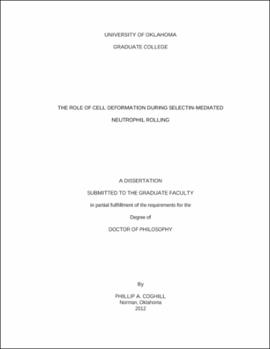| dc.contributor.advisor | Schmidtke, David W | |
| dc.creator | Coghill, Phillip | |
| dc.date.accessioned | 2019-04-27T21:38:06Z | |
| dc.date.available | 2019-04-27T21:38:06Z | |
| dc.date.issued | 2012 | |
| dc.identifier | 9938249302042 | |
| dc.identifier.uri | https://hdl.handle.net/11244/319226 | |
| dc.description.abstract | Selectin-mediated neutrophil rolling on endothelial cells is an important step in the biological processes of inflammation and thrombosis. Conversely, it has also been implicated in the pathogenesis of various cardiovascular diseases. While there are many factors that affect this phenomenon, shear stress is among the most significant. Previous studies have demonstrated the effects of shear stress on the selectin/ligand interactions that sustain neutrophil rolling. However, the effects of cell deformation on neutrophil rolling are still under investigation. In this study, the effects of cell deformation on selectin-mediated rolling are investigated on two scales: (I)deformation on a local scale such as contact zone deformation or membrane tether formation and (II)deformation of the cell body on a global scale. | |
| dc.description.abstract | We present reflective interference contrast microscopy (RICM) as a low-cost alternative to current microscopy techniques used to visualize cell footprints during rolling (i.e. quantitative dynamic footprinting). RICM visualized neutrophil contact areas similar to those reported by qDF and also visualized the formation of membrane tethers from distinct adhesion points. We also use RICM to show that membrane tether formation and neutrophil contact area are dependent on shear stress rather than shear rate. | |
| dc.description.abstract | Alternatively, using differential interference contrast (DIC) microscopy we demonstrate that increased membrane tether lifetime correlates with increasing P-selectin density while increased tether length correlates with increased shear stress. We also report the characterization of membrane tether formation on recombinant human P- and E-selectin-Fc chimeras. | |
| dc.description.abstract | Cellular deformation on a global scale has been suggested to occur as a result of the shearing force applied to an adherent cell by hemodynamic flow. Previous computational studies have related this shear effect to the ratio between the diameter of the cell (Dc) and the height of the channel being perfused (H). Although this Dc/H ratio can be large for neutrophils in post-capillary venules where leukocyte rolling typically occurs, many in vitro studies have used flow chambers where Dc/H is small (< 0.1). | |
| dc.description.abstract | To investigate leukocyte rolling in chambers with dimensions similar to post-capillary venules, we fabricated microfluidic chambers with various cross-sectional dimensions that required perfusion rates as low as 40 nL/min. We observed a significant decrease in neutrophil rolling velocity on P-selectin that correlated with decreasing chamber height (increasing Dc/H). Comparable studies with fixed cells and PSGL-1 coated microspheres, as well as contact area measurements made with RICM, demonstrated this velocity decrease was related to cell deformability. | |
| dc.description.abstract | Likewise, we fabricated bifurcated microfluidic chambers to investigate the impact of chamber geometry on neutrophil adhesion. Neutrophils accumulated at the bifurcation apex in P-selectin coated chambers at shear stresses as high as 100 dynes/cm2. Similarly, we used fixed cells to demonstrate that this accumulation is related to cellular deformation. We also report that adherent cell accumulation is dependent on specific molecular interactions, P-selectin coating concentration and the geometric properties of the chambers (e.g. bifurcation angle and channel cross-section dimensions). | |
| dc.format.extent | 201 pages | |
| dc.format.medium | application.pdf | |
| dc.language | en_US | |
| dc.relation.requires | Adobe Acrobat Reader | |
| dc.subject | Neutrophils | |
| dc.subject | Selectins | |
| dc.subject | Endothelium--Cytology | |
| dc.subject | Cell adhesion | |
| dc.title | The Role of Cell Deformation During Selectin-Mediated Neutrophil Rolling | |
| dc.type | text | |
| dc.type | document | |
| dc.thesis.degree | Ph.D. | |
| ou.group | College of Engineering::School of Chemical, Biological and Materials Engineering | |
